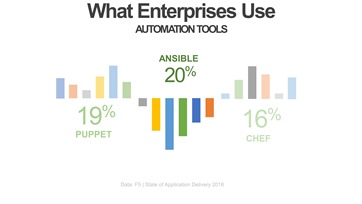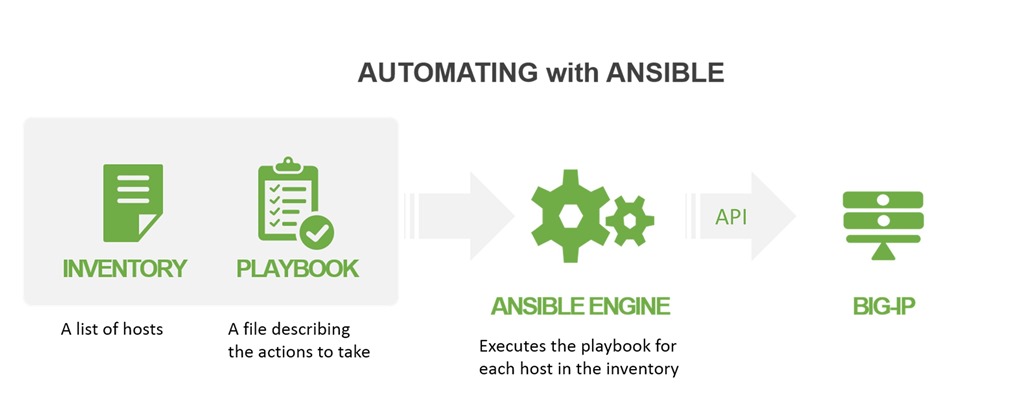Foco de código abierto: Novedades de F5 en Ansible 2.5

- Ansible 2.5 ya está disponible
- Se han agregado nuevos módulos F5 con más perfiles de seguridad, soporte de licencias y monitoreo.
- Puede obtener más información sobre nuestro portafolio de módulos F5 Ansible en Github
La automatización es un componente central del enfoque DevOps para las implementaciones que actualmente están arrasando en las TI empresariales. Si bien solo vemos unas pocas organizaciones (algunas podrían decir valientes, otras podrían decir locas) que usan la automatización el 100 % del tiempo para impulsar cambios menores y mayores en producción, la mayoría está usando la automatización al menos parcialmente en este momento. Ese uso seguirá expandiéndose a medida que la transformación digital presione a TI para escalar a un ritmo que solo puede ser igualado por la automatización.
Esto significa que las operaciones de red tienen que entrar en el juego de la automatización, utilizando las herramientas del oficio. Según nuestro último informe sobre el estado de la entrega de aplicación , esas herramientas son principalmente Ansible, Puppet y Chef.
Pero antes de que NetOps pueda hacer eso, es responsabilidad de quienes brindamos los servicios de red y aplicación necesarios (y a menudo requeridos) entregar aplicaciones de manera segura y a escala para respaldar esos conjuntos de herramientas.
Y ese es el motivo de este post de hoy. F5 ha estado apoyando la necesidad de NetOps de avanzar con la automatización proporcionando módulos Ansible desde hace bastante tiempo. El lanzamiento de Ansible 2.5 no es una excepción, y nos complace señalar que hemos mejorado los módulos F5 existentes y también hemos agregado otros nuevos para ampliar el soporte para la seguridad (y tal vez incluso incluir a SecOps en el juego de la automatización).
Si no está familiarizado con la automatización con Ansible, aquí tiene una presentación de treinta segundos: Ansible es un motor de código abierto y sin agentes que automatiza la configuración de uno o más hosts según lo descrito por las directivas en un libro de estrategias.

Es un modelo declarativo, lo que significa que el libro de jugadas describe acciones y proporciona valores (como nombres de host o direcciones IP o configuraciones específicas como un algoritmo de equilibrio de carga) y nada más. Los módulos Ansible tienen la tarea de leer el libro de estrategias y ejecutar comandos para lograr el resultado deseado. El motor Ansible se puede ejecutar en una computadora de escritorio, una computadora portátil o un servidor.
Es extremadamente adecuado para organizaciones que adoptan un enfoque de infraestructura como código para las implementaciones y aísla a los usuarios de los cambios en los módulos a lo largo del tiempo. Por lo tanto, incluso si algo cambia radicalmente con respecto a BIG-IP que requiera una actualización del módulo Ansible, no debería afectar los playbooks existentes. Puede leer más sobre BIG-IP y Ansible en DevCentral, así como encontrar ejemplos de manuales de estrategias y ayuda para usar ambos.
Ya sea que recién esté comenzando o sea un profesional de Ansible, querrá saber qué novedades hay en Ansible 2.5 con respecto a BIG-IP. Te cubro las espaldas allí. Hemos agregado módulos para admitir alta disponibilidad, perfiles BIG-IP ASM, políticas BIG-IP AFM y compatibilidad con iApp LX, entre otros. Esto se suma a los módulos existentes que cubren una amplia gama de capacidades de equilibrio de carga y seguridad disponibles con BIG-IP. La lista completa con enlaces en los que se puede hacer clic se encuentra debajo del pliegue.
Ansible es una de las herramientas más populares para la automatización de servicios de redes y aplicación . Estamos entusiasmados de ser parte de la comunidad Ansible y apoyar a NetOps en su transición hacia un modelo de implementación más automatizado e impulsado por software con DevOps.
¡Automatiza todas las cosas!
A continuación se muestra una lista parcial de las novedades de Ansible 2.5:
Módulo Ansible |
Descripción |
Administra las listas de direcciones AFM en un BIG-IP |
|
Administra las listas de puertos AFM en un BIG-IP |
|
Importar políticas de ASM desde un archivo o una plantilla existente |
|
Administra licencias en un grupo de claves de registro de BIG-IQ |
|
Administra grupos de claves de registro en BIG-IQ |
|
Emparejamiento de alta disponibilidad BIG-IP |
|
Implementa paquetes iApps LX en BIG-IP |
|
Administra las reglas de política LTM en una BIG-IP |
|
Administra los monitores UDP de F5 BIG-IP LTM |
|
Administra los monitores HTTPS de F5 BIG-IP LTM |
|
Administra grupos de tráfico en BIG-IP |
|
Administra invitados vCMP en una BIG-IP |
|
Administra perfiles SSL de cliente en una BIG-IP |
